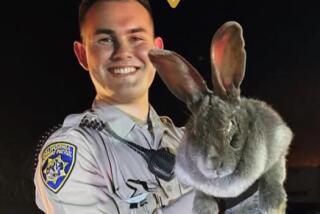One giant leap for 20 tiny rabbits
- Share via
EPHRATA, WASH. — Two groups of tiny, dark-eyed, salt-and-pepper rabbits were released in a sagebrush field in eastern Washington last week, raising the population of Columbia Basin pygmy rabbits in the wild from zero to 20.
They are the smallest rabbits in the United States and one of only two types in North America that dig their own burrows. Adults weigh about a pound, and measure a foot long. The Columbia Basin rabbits are a genetically distinct sub-population of the Great Plains pygmy rabbits found in California, Washington, Idaho, Oregon, Montana, Utah and Nevada.
Plunging populations brought the rabbits to the attention of Washington state biologists in the late 1980s and early ‘90s. The state listed the animals as endangered in 1993 and began developing a recovery plan.
The rabbits released last week -- eight from Portland, Ore., and 12 from Pullman -- are the descendants of 16 rabbits captured in 2001 for an experimental breeding program, a joint effort of the state of Washington, the U.S. Fish and Wildlife Service, and other public and private partners.
At that time, the population was about 40. In 2003, the rabbits were listed as endangered by the federal government, and by 2004, scientists in eastern Washington found none left to count.
Chris Warren, federal coordinator of the pygmy rabbit program, likens the effort to the reintroduction of the California condor.
In 1982, there were only 22 California condors left, all part of a captive breeding program. Today, 127 condors have been released to the wild, and 152 remain in breeding facilities. That program is estimated to have cost $40 million.
“It’s very rare for us to be able to reintroduce a population after they’ve disappeared from the land,” Warren said. “It’s extraordinary to have this success in the breeding program and to have the opportunity to save the population. The credit all goes to Washington state.”
Other species being bred include black-footed ferrets on the Great Plains, Peninsular big horn sheep in California, and the Attwater’s prairie chicken in Louisiana and Texas.
It hasn’t been easy getting the pygmy rabbits this far. The program has been through many ups and downs and has cost about $3 million over the last six years. The Columbia Basin pygmies are shy and reclusive and lack one important trait common in most rabbits. “Everyone knows the phrase ‘breed like bunnies,’ ” said Oregon Zoo Conservation Manager Anne Warner. “Well, these don’t.”
The Oregon Zoo, along with Washington State University and Northwest Trek Wildlife Park south of Tacoma, is one of the three captive breeding facilities in the program.
“The rabbits were actually so inbred that they were missing a bone in one foot,” Warner said. That inbreeding, along with disease, predators and loss of habitat, is thought to be a major factor in the populations’ precipitous decline.
“We tried to breed rabbits solely from Columbia Basin stock, but they did not produce enough healthy offspring to allow for reestablishment into the wild,” said Dave Hays, a biologist with the state of Washington. In the end, biologists had to crossbreed the original Columbia Basin pygmies with a distinct population of Idaho pygmies.
The offspring are genetically 75% Columbia Basin pygmy rabbit, a percentage that has been deemed high enough to count as a survival of the species. That percentage may increase as successive generations are bred and returned to the wild.
Another important part of the picture is the management and enhancement of the rabbits’ habitat.
This first release took place Tuesday on Washington’s Sagebrush Flat Wildlife Area, a 3,700-acre reserve. The state is working with a coalition of partners to put together up to 10,000 acres of shrub steppe, the habitat the animals require: flat treeless land, dominated by olive-colored sagebrush and loose soil for burrowing.
Two rabbits, one from the Oregon Zoo in Portland and one from Washington State University, were introduced to about 45 people, including representatives from state and federal agencies, private conservation groups, local landowners and reporters.
Grasshopper, the rabbit from WSU, quickly became nervous in front of the cameras and the crowd, squirming in the hands of Becky Elias, a research assistant, who returned him to his cardboard carrier. Tug, the Oregon Zoo pygmy, lasted in public a few minutes longer. Zoo technician Rachel Lamson pointed out the radio antenna on his collar, which extended an inch or so beyond Tug’s left ear. “You can see where he’s been chewing on it a little,” Lamson said.
All the rabbits released were fitted with these radio collars, which will allow biologists to monitor them and track their progress. More than 70 animals remain in the captive breeding facilities, and Warren said the releases would become regular events.
“We have to keep a close eye on them and see how well they do,” he said, “but if it all goes as we hope, we should be releasing rabbits in this area for the next three years. By then, we should know if they are increasing on their own.”
Washington Department of Fish and Wildlife Director Jeff Koenings, who attended the release, called it “historic.”
“We are committed to preventing the loss of the pygmy rabbit from our state’s diverse wildlife heritage,” he said.
More to Read
Sign up for Essential California
The most important California stories and recommendations in your inbox every morning.
You may occasionally receive promotional content from the Los Angeles Times.













